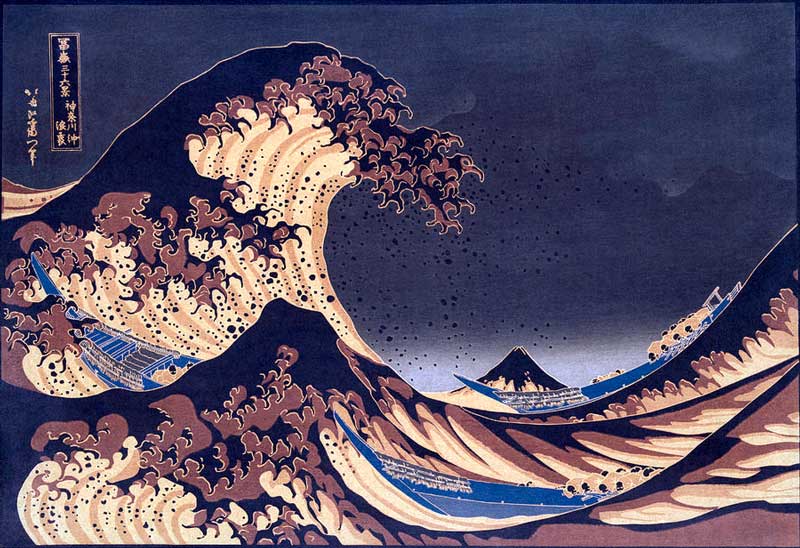
The Great Wave of Kanagawa, by Katsushika Hokusai, depicting three boats in heavy seas on the verge of facing the eponymous wave in front of Mount Fuji standing in the distance as a mute witness, is probably one of the most famous examples in Japanese art. The most prominent feature of the painting, also known as the Great Wave, is the extended wave that is about to break with the crash of its claw-like crest. The giant wave that seems to be an enormous monster is about to strike the three fishing boats, symbolizing the tremendous force and power of nature in contrast with the helplessness of mankind against its fury. While the gigantic wave in the foreground represents the unpredictability of life, Mount Fiji in the background, a sacred object in Japanese belief, signifies stillness and eternity. Although the mountain is made tiny by the use of perspective, the spray from the crown of the crashing wave seems like a shower of snow on the top of the mountain.

Since its creation nearly two centuries ago, the Great Wave has been identified as a symbol of natural disaster, and it is often mobilized as a symbol of not only tsunamis, but also hurricanes and plane crashes in the sea. Probably, due to its various interpretations, it has become a global icon, which is instantly recognizable like a classical work of literature, a path-breaking film, a painting, or a symphony.
Hokusai had an aptitude for painting, and he began painting when he was only six. However, at the tender age of twelve, he was imposed by his father to work in a bookshop. At sixteen, he was apprenticed to a wood-engraver and spent three to four years to learn the trade. In the meantime, he also started to produce his own illustrations. At eighteen, he joined as an apprentice in the studio of Katsukawa Shunsho, one of the reputed Ukiyo-e artists, and the head of the so-called Katsukawa School. In 1814, he published the first of the fifteen volumes of his sketches, titled Manga. His Thirty-six Views of Mount Fiji, containing The Great Wave, was produced in the early 1830s.

Created between 1830 and 1833, The Wave is a woodblock print, made of ink and colour on paper of around 10X14 inches, and is part of a series of prints titled Thirty-six views of Mount Fiji. Within no time, the initial thousands of copies of the print were sold among the public.
Although the print reflects the influence of Western art, especially Dutch paintings that he saw in Nagasaki, later it proved to be inspirational for many European artists in the nineteenth century.

The series, considered the masterpiece of Katsushika Hokusai, was created when the artist was around seventy. It made use of Prussian blue, a new item in the country imported from England through China. Initially, the images were largely printed in blue tones. However, with its assured success, multicoloured versions of the prints were released. Printed in vibrant and glowing colours with the riveting use of space, the prints depict the peak of the towering wave from different angles and conditions.

Many of the original impressions of around 5,000 copies have been lost in wars, fires, earthquakes, and other unavoidable circumstances. But the few survived early impressions indicate sharp lines of the woodblocks. However, with the growing popularity of the series, the printing of copies continued, resulting in significant natural wear of the woodblocks. Eventually, the quality of the image of the subsequent impressions deteriorated considerably.
Apart from Japan, original impressions of the print are housed in several Western institutions that include the British Museum in London, the Art and History Museum in Brussels, Claude Monet’s home in Giverny, France, the Art Institude of Chicago, the Metropolitan Museum of Art in New York, and the National Gallery of Victoria in Melbourne.
